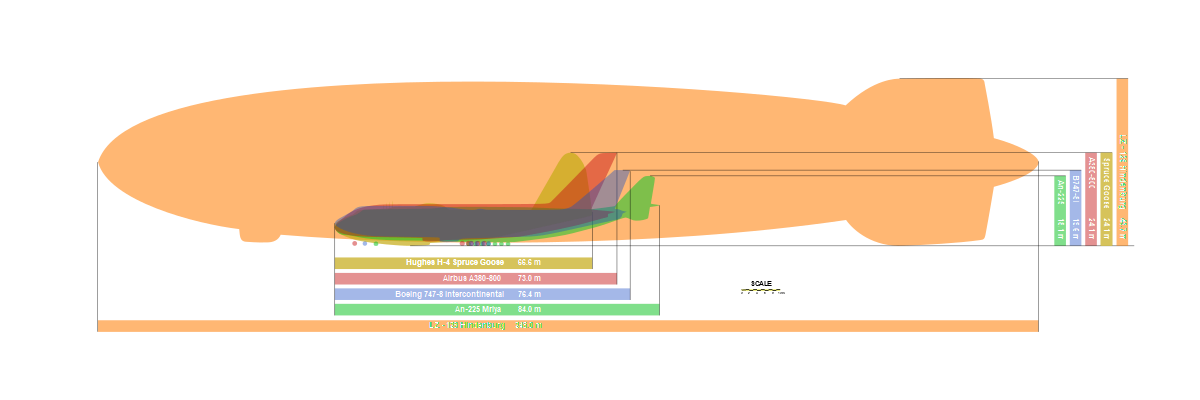A Quick Overview of Airships
There is a lot to know and learn about Airships, that's part of the fun. But the basic principles are not hard to understand.
This page is just meant to be a quick introduction to get you up to speed if you are new to the world of Dirigible Aerostats.
Let's look at the relative scale of the largest airship ever (ok, one of two LZ129 and LZ130), versus the largest airplanes to date.

The Hindenburg vs Spruce Goose, Airbus A380-800, Boeing 747-8, and AN-225 Mriya
The Hindenburg's length is 3/4 of the height of the Empire State Building, which was built as an airport for Zeppelins!
Vessels that carry people into the sky can be split into two main categories:
- Buoyant Lift such vessels are called "Aerostats" such as balloons, blimps and zeppelins; and
- Propulsion Lift which are called "Aerodynes" this category includes airplanes, helicopters and rockets.
- We will note a special sub-category of Aerodyne here -- gliders, which use the mechanical lift of their wings and air-currents (updrafts especially) to stay aloft. So they use external, natural 'propulsion' to gain lift.
The category we are interested in for Airships, is Buoyant Lift, any vessel using buoyancy for lift is called an Aerostat. This buoyancy comes from a container - usually called the envelope, which is filled with a gas that is lighter than the surrounding air, causing the envelope to 'float.' The first versions were simply filled with hot-air which is less dense than the surrounding air and so it rises. Hot-Air balloons remain the most common form of aerostat in use.
Instead of hot-air, the envelope can also be filled with any 'lighter-than-air' gas, such as Hydrogen or Helium, but sometimes Ammonia. Theoretically a vacuum would work, but the weight of the structure required to hold the shape of the envelope far exceeds the lift advantage of a vacuum over lifting gas.
The thing about hot-air balloons is that, while elevation can be controlled with ballast, vents and heating, the direction of the balloon is at the mercy of the prevailing winds. Which, for the adventurer may be part of the fun—Riding the Wind! However, this limits the practical applications of a balloon.
Naturally, folks started to think about how to steer a balloon, and thus make it 'direct-able' or in French Dirigible.
This gives us the major division of Aerostats - Dirigible and Non-Dirigible: Airships and Balloons.
So, an Airship is a vessel using buoyancy to float on air, along with some form of propulsion to provide control over its direction and speed.
I called this site Skyships, after a less used term, that may be more fanciful, but it really means just the same thing as "airship."
- The first balloon flight was a distance of 1.2 killometers, in 1782 in a vessel made by the Montgolfier brothers.
- Henri Giffard flew the world's first airship in 1852!
- The first successful attempts at dirigibles occurred in the middle of the 1800's,
almost 50 years before the Wright Brother's flight at Kitty Hawk!
Airships have two main categories: Rigid and Non-Rigid, with several hybrid or Semi-Rigid vessels between the two.
To get an idea, lets look at the Vessels whose names we recognize:
Rigid-Airships think 'Zeppelin'.
The name comes from the Zeppelin company, and many rigid airships were not 'Zeppelins' but we often use the term generically, due to the great successes of the Zeppelin Airships. Of course, the first Zeppelin most of us think of is the Hindenburg, because of it's famous disaster, but it's older sister the Graf Zeppelin had a very long and successful run.
Count Ferdinand von Zeppelin (1838-1917) is the inventor of the Rigid-Airship, an idea he first expressed in his diary on 25 March 1874.
Not always easy to recognize, but the mature Zeppelin design included usable holds, cabins and walkways inside the main body of the airship!
Non-Rigid Airships Also called 'blimps'
The gas-envelope of a blimp can be deflated and folded up, it may have some batons to keep the shape of the nose, but it holds its shape from the gas filling it, like an balloon. The difference is that a Blimp has a gondola and propellers that attach to the envelope to carry people and cargo, and to give it propulsion.
The most recognized Blimp is of course the Goodyear Blimp. (Most folks don't realize that in its hey-day of airship construction it was the Goodyear-Zeppelin company - a joint venture.)
Hybrid Airship Ok, most folks won't recognize these, but the most famous was the Norge. An Italian made Semi-Rigid Airship, used by the Famous Polar Explorer Roald Amundsen to fly over the North Pole. The American, Richard E. Byrd, Amundsen's friend, arrived at Amundsen's camp, spent the night with him and then flew on in his airplane to claim the first flight over the North Pole, just a couple of days ahead of Amundsen.
Polar Exploration aficionados can argue over the validity of the various claims, but Amundsen's crossing the Pole aboard the Norge remains undisputed.
The Future of LTA:
It is important to know that the effort to produce commercial and military airships has never stopped. Today a number of countries have airship programs: developing airships for the future. Airships, although not as fast and more susceptible to side-winds, remain about 10-times as fuel efficient as airplanes and don't need established airstrips for take-off and landing! And, they can remain aloft far longer than airplanes.
Well, now you know enough to impress your friends, and we hope enough to spark an interest in knowing more... If so, please enjoy our website, explore the many other webpages dedicated to airhsips, and welcome to the wonderful world of Sky-Ships!
'Main' Group
SideBar
Steamport HowTo:
Learn how to Wiki:
- PmWiki
- Basic Editing
- Full Index
- PmWiki FAQ
- Initial Setup Tasks
- PmWikiPhilosophy
- Release Notes
- ChangeLog
Local PMWiki:

